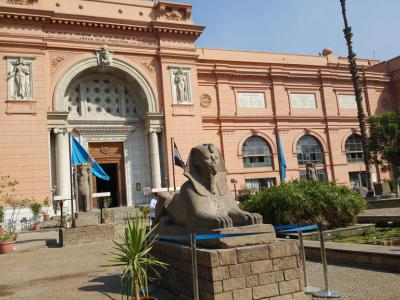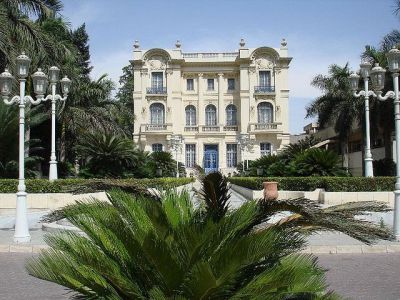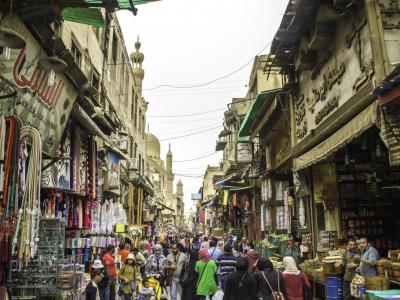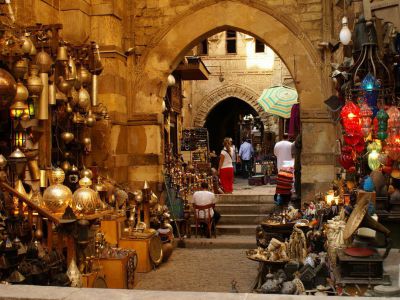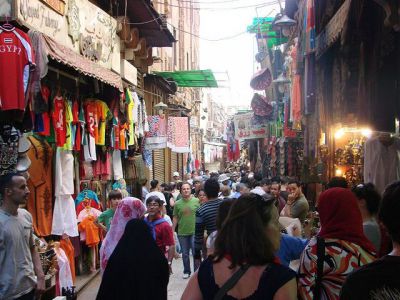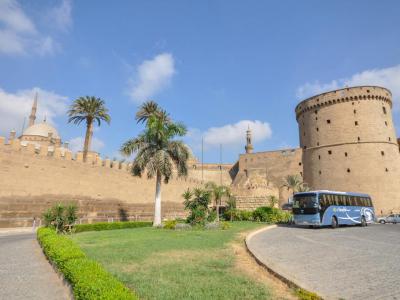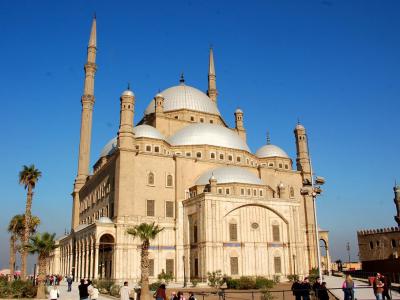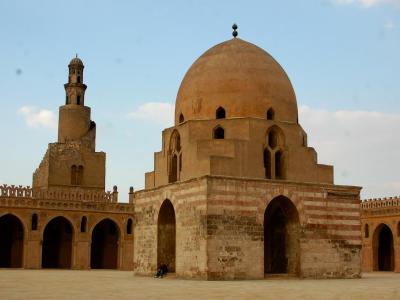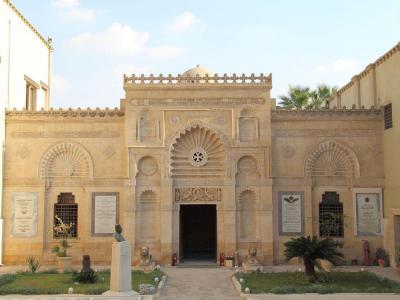Custom Walk in Cairo, Egypt by msamusik_985f7 created on 2025-05-08
Guide Location: Egypt » Cairo
Guide Type: Custom Walk
# of Sights: 9
Tour Duration: 6 Hour(s)
Travel Distance: 17 Km or 10.6 Miles
Share Key: BDRDA
Guide Type: Custom Walk
# of Sights: 9
Tour Duration: 6 Hour(s)
Travel Distance: 17 Km or 10.6 Miles
Share Key: BDRDA
How It Works
Please retrieve this walk in the GPSmyCity app. Once done, the app will guide you from one tour stop to the next as if you had a personal tour guide. If you created the walk on this website or come to the page via a link, please follow the instructions below to retrieve the walk in the app.
Retrieve This Walk in App
Step 1. Download the app "GPSmyCity: Walks in 1K+ Cities" on Apple App Store or Google Play Store.
Step 2. In the GPSmyCity app, download(or launch) the guide "Cairo Map and Walking Tours".
Step 3. Tap the menu button located at upper right corner of the "Walks" screen and select "Retrieve custom walk". Enter the share key: BDRDA
1) The Museum of Egyptian Antiquities (must see)
The Egyptian Antiquities Museum, popularly known as the Egyptian Museum is a repository of the largest collection of ancient Egyptian objects in the world. It is located to the north of Tahrir Square next to the Nile Hilton hotel.
The Egyptian Museum was established to prevent the removal of Egyptian treasures by foreigners in the 1830s. It first occupied a building in Bulaq on the banks of the River Nile in 1863. After many objects were damaged when the building was flooded, a new museum was built. The present building was designed by French architect, Marcel Dourgnon and inaugurated in 1902.
The Egyptian Museum has a collection of over 120,000 items. Notable exhibits are objects from Pharaoh Tutankhamen’s tomb displayed on the second floor including a gold funerary mask and sarcophagus. The second floor also has a Mummy room with the mummified remains of 11 kings and queens. One room on the same floor displays mummified birds and animals found in royal tombs. The ground floor has a collection of papyrus and coins. The collection not only has papyrus and coins from the age of the Pharaohs but also from the Greek and Roman civilizations. There is also a collection of coins minted under Islamic rule. Other objects displayed on the ground floor are tablets, statues and coffins from the age of the Pharaohs.
Why You Should Visit:
Great location in the heart of the city and the place to visit for a unique and famous Egyptian antiquities collection.
You can get a lot closer to the exhibits than you'd expect and see some amazing history up close.
Tip:
Try to visit with a professional guide, preferably a trained Egyptologist. Do not hire a random person outside.
If you can plan your visit on a day that they are open in the evening, you'll be rewarded with a smaller crowd of people.
Make sure you download/screenshot a map of each floor onto your device. Mark the items you don't want to miss before you go. A little research will save a lot of time!
The Egyptian Museum was established to prevent the removal of Egyptian treasures by foreigners in the 1830s. It first occupied a building in Bulaq on the banks of the River Nile in 1863. After many objects were damaged when the building was flooded, a new museum was built. The present building was designed by French architect, Marcel Dourgnon and inaugurated in 1902.
The Egyptian Museum has a collection of over 120,000 items. Notable exhibits are objects from Pharaoh Tutankhamen’s tomb displayed on the second floor including a gold funerary mask and sarcophagus. The second floor also has a Mummy room with the mummified remains of 11 kings and queens. One room on the same floor displays mummified birds and animals found in royal tombs. The ground floor has a collection of papyrus and coins. The collection not only has papyrus and coins from the age of the Pharaohs but also from the Greek and Roman civilizations. There is also a collection of coins minted under Islamic rule. Other objects displayed on the ground floor are tablets, statues and coffins from the age of the Pharaohs.
Why You Should Visit:
Great location in the heart of the city and the place to visit for a unique and famous Egyptian antiquities collection.
You can get a lot closer to the exhibits than you'd expect and see some amazing history up close.
Tip:
Try to visit with a professional guide, preferably a trained Egyptologist. Do not hire a random person outside.
If you can plan your visit on a day that they are open in the evening, you'll be rewarded with a smaller crowd of people.
Make sure you download/screenshot a map of each floor onto your device. Mark the items you don't want to miss before you go. A little research will save a lot of time!
2) Khalil Museum
The Khalil Museum houses the collection of art and objects of Mohamed Mahmoud Khalil, a prominent Egyptian politician and his wife Emiline Lock. It consists of many valuable paintings and rivals many private European art collections.
The Mohamed Khalil palace that houses the Museum was built in 1920 in Giza, Cairo. It has an art deco style of architecture. The eastern part of the palace that overlooks the River Nile has an art nouveau style and includes a metal and glass skeleton above the main entrance. The building covers an area of 1400 square meters and has four floors. It became a museum in 1962. The collection was temporarily moved to another palace in the Zamaleck area of Cairo and returned once the Khalil palace was extensively renovated in 1971.
The Khalil Museum has a valuable collection of European painting by great masters including Paul Gaugin, Claude Monet, Auguste Renoir and Vincent Van Gogh. The paintings, ‘Sun Flower’ by Vincent van Gogh and ‘Life and Death’ by Paul Gaugin are placed in individual rooms for visitors to marvel in private. There is also an impressive collection of vases from France, China, Japan, Iran and Egypt and a vast collection of Chinese miniature figures.
The Mohamed Khalil palace that houses the Museum was built in 1920 in Giza, Cairo. It has an art deco style of architecture. The eastern part of the palace that overlooks the River Nile has an art nouveau style and includes a metal and glass skeleton above the main entrance. The building covers an area of 1400 square meters and has four floors. It became a museum in 1962. The collection was temporarily moved to another palace in the Zamaleck area of Cairo and returned once the Khalil palace was extensively renovated in 1971.
The Khalil Museum has a valuable collection of European painting by great masters including Paul Gaugin, Claude Monet, Auguste Renoir and Vincent Van Gogh. The paintings, ‘Sun Flower’ by Vincent van Gogh and ‘Life and Death’ by Paul Gaugin are placed in individual rooms for visitors to marvel in private. There is also an impressive collection of vases from France, China, Japan, Iran and Egypt and a vast collection of Chinese miniature figures.
3) Muizz Street (must see)
Al-Muizz Street holds a significant place in the ancient walled city of historic Cairo, running from north to south. It's considered one of Cairo's oldest thoroughfares, dating back to the 10th century when the Fatimid dynasty established the city, under their fourth caliph, Al-Mu'izz li-Din Allah, after whom the street is named.
Throughout history, this street was the lifeline of the city and often referred to as the Qasaba. It served as the primary economic hub, hosting bustling markets. The street's importance led to the construction of numerous grand religious and charitable structures, commissioned by Egypt's rulers and elites. As a result, Al-Muizz Street has become a treasure trove of historic Islamic architecture in Cairo, particularly in the Bayn al-Qasrayn area, where you'll find some of Islamic Cairo's most significant monuments.
In 1997, the national government embarked on an extensive renovation project for the historical buildings, modern structures, pavement, and sewer system with the aim of transforming the street into an "open-air museum."
The renovations sought to restore the street's original appearance. Taller buildings that obscured the view of monuments were reduced in height and painted in suitable colors, while the street was repaved in its original style. Furthermore, the street's nighttime ambiance was updated through the installation of advanced exterior lighting systems on buildings.
Why You Should Visit:
There are more sites and attractions than you can count on Muizz Street. A UN study found that this one street has the most fantastic collection of medieval architectural treasures in the Islamic world. You'll find dozens of mosques, madrasas, and hamams, along with shops, restaurants, and markets.
Nearby Khan Al-Khalili Bazaar is a major souq (market) and is popular with locals and tourists. It's a great place to enjoy dinner or lunch and buy some souvenirs.
While all of the buildings along Muizz Street are architectural treasures, don't miss the Azhar Mosque, Cairo's first mosque built in 970. Also, visit Bab Zuweila, the medieval gate into the walled city, and one of Cairo's most important landmarks.
Tips:
Visit the street in the evening to see the buildings illuminated with special lighting. The vibe at night is entirely different, with lots of street food and people enjoying the cooler air.
Many attractions and monuments charge an extra fee for bringing your camera.
Remember that weekends here are Friday and Saturday, and that's when you'll find Muizz Street and all of its attractions the busiest.
Throughout history, this street was the lifeline of the city and often referred to as the Qasaba. It served as the primary economic hub, hosting bustling markets. The street's importance led to the construction of numerous grand religious and charitable structures, commissioned by Egypt's rulers and elites. As a result, Al-Muizz Street has become a treasure trove of historic Islamic architecture in Cairo, particularly in the Bayn al-Qasrayn area, where you'll find some of Islamic Cairo's most significant monuments.
In 1997, the national government embarked on an extensive renovation project for the historical buildings, modern structures, pavement, and sewer system with the aim of transforming the street into an "open-air museum."
The renovations sought to restore the street's original appearance. Taller buildings that obscured the view of monuments were reduced in height and painted in suitable colors, while the street was repaved in its original style. Furthermore, the street's nighttime ambiance was updated through the installation of advanced exterior lighting systems on buildings.
Why You Should Visit:
There are more sites and attractions than you can count on Muizz Street. A UN study found that this one street has the most fantastic collection of medieval architectural treasures in the Islamic world. You'll find dozens of mosques, madrasas, and hamams, along with shops, restaurants, and markets.
Nearby Khan Al-Khalili Bazaar is a major souq (market) and is popular with locals and tourists. It's a great place to enjoy dinner or lunch and buy some souvenirs.
While all of the buildings along Muizz Street are architectural treasures, don't miss the Azhar Mosque, Cairo's first mosque built in 970. Also, visit Bab Zuweila, the medieval gate into the walled city, and one of Cairo's most important landmarks.
Tips:
Visit the street in the evening to see the buildings illuminated with special lighting. The vibe at night is entirely different, with lots of street food and people enjoying the cooler air.
Many attractions and monuments charge an extra fee for bringing your camera.
Remember that weekends here are Friday and Saturday, and that's when you'll find Muizz Street and all of its attractions the busiest.
4) Khan El Khalili
Khan el-Khalili stands as a renowned marketplace situated in the historical heart of Cairo. It originated during the Mamluk era, serving as a hub for trade and derived its name from one of the numerous ancient caravanserais that dotted the area-these were essentially roadside inns. Over time, this bazaar district has evolved into a significant attraction, drawing both tourists and Egyptians alike. Moreover, it serves as the domicile for numerous Egyptian artisans and workshops, specializing in the creation of traditional crafts and souvenirs.
Presently, Khan el-Khalili predominantly houses local vendors and traders with a considerable emphasis on catering to tourists. Typical items found in its shops include souvenirs, antiques, and jewelry. The adjacent goldsmiths' souq still retains its significance among the local population. While not as prevalent as in the past, many craft workshops continue to operate within the bazaar, primarily located in courtyards or upper floors of buildings, contributing to the creation of products sold here or exported elsewhere.
Beyond shopping, the market features various coffeehouses, restaurants, and street food stalls scattered throughout its premises. These coffeehouses are often characterized by their modest size and adherence to traditional practices, offering Arabic coffee and frequently providing shisha (hookah). Among these establishments, El Fishawi's, founded in 1773, stands out as one of the oldest and most renowned coffeehouses in the area.
Presently, Khan el-Khalili predominantly houses local vendors and traders with a considerable emphasis on catering to tourists. Typical items found in its shops include souvenirs, antiques, and jewelry. The adjacent goldsmiths' souq still retains its significance among the local population. While not as prevalent as in the past, many craft workshops continue to operate within the bazaar, primarily located in courtyards or upper floors of buildings, contributing to the creation of products sold here or exported elsewhere.
Beyond shopping, the market features various coffeehouses, restaurants, and street food stalls scattered throughout its premises. These coffeehouses are often characterized by their modest size and adherence to traditional practices, offering Arabic coffee and frequently providing shisha (hookah). Among these establishments, El Fishawi's, founded in 1773, stands out as one of the oldest and most renowned coffeehouses in the area.
5) Khan Al-Khalili Bazaar (must see)
The Khan Al-Khalili Bazaar popularly called the Khan is one of the oldest markets in Egypt. This open-air market retains the medieval ambience of a traditional Arab market till today.
The Khan Al-Khalili Bazaar was established as a large caravanserai by Emir Jaharks al Khalili in 1382 during the reign of the Burji Mamluk Sultan, Barkuk. It was rebuilt many times after its establishment. It was called the Turkish Bazaar under the rule of the Ottoman Turks. Its popularity among foreign tourists looking for bargains has also made it the target of terrorist attacks.
The Khan Al-Khalili Bazaar has shops selling textiles, spices, traditional arts and crafts, jewelry and perfumes. There are also several street hawkers selling small souvenirs at bargain prices for visitors to take home as mementos. Egyptians prefer shopping at the west of the market where gold and silver objects and jewelry are available. Beyond the gold and silver market are canvas covered shops selling bronze and copper artifacts. There are also many restaurants, hookah bars (called Shisha bars) and coffee houses serving traditional Arabian coffee. The El-Fishawi Café or café of mirrors is a favorite among local artists and writers and is frequented by the Nobel Prize-winning writer Naguib Mahfouz. The bazaar is the setting of his novel, 'Midaq Alley'.
Tip:
Prepare to have your haggling skills challenged! Entertain only if you wish to buy something specific and never accept the first price.
Don't stray too far off the main shopping street because of pickpockets and other dangers.
Visit in the day as well as the night – completely different vibes!
The Khan Al-Khalili Bazaar was established as a large caravanserai by Emir Jaharks al Khalili in 1382 during the reign of the Burji Mamluk Sultan, Barkuk. It was rebuilt many times after its establishment. It was called the Turkish Bazaar under the rule of the Ottoman Turks. Its popularity among foreign tourists looking for bargains has also made it the target of terrorist attacks.
The Khan Al-Khalili Bazaar has shops selling textiles, spices, traditional arts and crafts, jewelry and perfumes. There are also several street hawkers selling small souvenirs at bargain prices for visitors to take home as mementos. Egyptians prefer shopping at the west of the market where gold and silver objects and jewelry are available. Beyond the gold and silver market are canvas covered shops selling bronze and copper artifacts. There are also many restaurants, hookah bars (called Shisha bars) and coffee houses serving traditional Arabian coffee. The El-Fishawi Café or café of mirrors is a favorite among local artists and writers and is frequented by the Nobel Prize-winning writer Naguib Mahfouz. The bazaar is the setting of his novel, 'Midaq Alley'.
Tip:
Prepare to have your haggling skills challenged! Entertain only if you wish to buy something specific and never accept the first price.
Don't stray too far off the main shopping street because of pickpockets and other dangers.
Visit in the day as well as the night – completely different vibes!
6) The Citadel (must see)
The Cairo Citadel on Mokattam Hill is a large Islamic fortification commanding spectacular views of the city. Many landmark Mosques and museums are located here today.
The Cairo Citadel served as a place where Sultans from the Mamluk Dynasties came for the cool air and to enjoy the spectacular views. It was the Ayyubid Ruler Salah-ad-Din who realized the strategic advantage of fortifying the citadel to protect the city from the crusaders. The wall around the citadel was constructed between 1176 and 1183. It served both as a fortress and a Royal City at the time. The Mamluk Sultan, Al Nasir Muhammad regained power in the 1330s and destroyed most of the Ayyubid structures. Later the Ottoman rulers, tore down most of the Mamluk buildings in the 1800s.
Today, only the walls of the Ayyubid fortress and the Bir Yusuf or Saint Josephs Well remain from the original structure. The green domed Mosque of Al Nasir Muhammad and a portion of his striped palace remain from the Mamluk era. All other structures are built by the Ottoman Rulers, in particular Muhammad Ali Pasha the founder of the last dynasty that ruled Egypt. The four museums that are now located within the Citadel are the Police Museum, the National Military Museum, the Carriage Museum and the Al-Gawhara Palace museum.
The Cairo Citadel served as a place where Sultans from the Mamluk Dynasties came for the cool air and to enjoy the spectacular views. It was the Ayyubid Ruler Salah-ad-Din who realized the strategic advantage of fortifying the citadel to protect the city from the crusaders. The wall around the citadel was constructed between 1176 and 1183. It served both as a fortress and a Royal City at the time. The Mamluk Sultan, Al Nasir Muhammad regained power in the 1330s and destroyed most of the Ayyubid structures. Later the Ottoman rulers, tore down most of the Mamluk buildings in the 1800s.
Today, only the walls of the Ayyubid fortress and the Bir Yusuf or Saint Josephs Well remain from the original structure. The green domed Mosque of Al Nasir Muhammad and a portion of his striped palace remain from the Mamluk era. All other structures are built by the Ottoman Rulers, in particular Muhammad Ali Pasha the founder of the last dynasty that ruled Egypt. The four museums that are now located within the Citadel are the Police Museum, the National Military Museum, the Carriage Museum and the Al-Gawhara Palace museum.
7) Mosque of Muhammad Ali (must see)
The Mosque of Muhammad Ali Pasha is located at the top of the Salah-ad-Din Citadel in Cairo. It is one of the most visited sites in Cairo.
The mosque was commissioned by the founder of modern Egypt and the last dynasty that ruled Egypt. It is also called the alabaster mosque because of the extensive use of the material in the structure. Unlike other mosques in Egypt that were built in the Mamluk architectural style, it had the style of Turkish Mosques especially the Yeni Mosque in Istanbul. It was designed by the Turkish architect, Yusuf Bushnak.
The Mosque of Muhammad Ali Pasha has a central dome surrounded by four small domes and four semicircular domes. The slender minarets have a Turkish architectural style and are 82 meters high. The tomb of Muhammad Ali Pasha is located at the center of the courtyard and is made of Carrara marble. The arcaded courtyard offers a spectacular view of the city across to the pyramids at Giza. The large prayer hall is covered by a large Turkish-style dome. The Southwestern parapet offers views of Cairo, the Sultan Hassan Mosque and the Ibn Tulun Mosque.
Why You Should Visit:
As part of the Citadel that you get to explore, this mosque stands out the most, especially at night with its beautiful illumination.
Add to this the design and intricacy of the mosaic inside, which truly makes it a great antiquity.
Because it sits on top of a mountain, you can also take in expansive views of the city and the pyramids.
Tip:
Try to go early in the morning or late afternoon to avoid the heat and go on a sunny day as well – makes a lot of difference when enjoying the view!
Be sure to ask the cost of the "tour guide" assistance before you agree to hear more about the mosque.
The mosque was commissioned by the founder of modern Egypt and the last dynasty that ruled Egypt. It is also called the alabaster mosque because of the extensive use of the material in the structure. Unlike other mosques in Egypt that were built in the Mamluk architectural style, it had the style of Turkish Mosques especially the Yeni Mosque in Istanbul. It was designed by the Turkish architect, Yusuf Bushnak.
The Mosque of Muhammad Ali Pasha has a central dome surrounded by four small domes and four semicircular domes. The slender minarets have a Turkish architectural style and are 82 meters high. The tomb of Muhammad Ali Pasha is located at the center of the courtyard and is made of Carrara marble. The arcaded courtyard offers a spectacular view of the city across to the pyramids at Giza. The large prayer hall is covered by a large Turkish-style dome. The Southwestern parapet offers views of Cairo, the Sultan Hassan Mosque and the Ibn Tulun Mosque.
Why You Should Visit:
As part of the Citadel that you get to explore, this mosque stands out the most, especially at night with its beautiful illumination.
Add to this the design and intricacy of the mosaic inside, which truly makes it a great antiquity.
Because it sits on top of a mountain, you can also take in expansive views of the city and the pyramids.
Tip:
Try to go early in the morning or late afternoon to avoid the heat and go on a sunny day as well – makes a lot of difference when enjoying the view!
Be sure to ask the cost of the "tour guide" assistance before you agree to hear more about the mosque.
8) Mosque of Ibn Tulun (must see)
The Mosque of Ibn Tulun is one of the largest, oldest and best-preserved mosques in Egypt. Some scenes of the James Bond movie, 'The Spy Who Loved Me', were filmed here.
The mosque was built between 870 and 879 by the Abbasid Governor Ahmad Ibn Tulun. He was a slave who founded the Tulunid Dynasty that ruled Egypt between 868 and 905. After the fall of the dynasty, the mosque was neglected for many years. It was restored in 1296 by the Mamluk Sultan Lajin. A recent major restoration was carried out in 1999 and the courtyard was paved and the fountain was covered with black marble.
Ibn Tulun Mosque covers an area of 6 acres. It is the third largest Mosque in the world. The galleries have intricately carved stucco arches. It was the first time that stucco was used in Egypt. The unique feature of the building is the minaret. Unlike other minarets, it has a spiral structure. The model is from the minarets found in Samarra, Iraq. A spiral staircase is found on the outside. The minaret arches have a horseshoe shape resembling the type of arches found in Spain and showing the influence of Muslim refugees who fled here after the re-conquest of Spain from the Moors.
Why You Should Visit:
To see what many people agree is one of the most beautiful mosques in Cairo, besides being the oldest intact mosque in the whole of Egypt.
You can enter the mosque to soak in the atmosphere or you can ask the people working there if you could just climb the minaret (me'zana) to get an amazing view of the old city.
Tip:
Before climbing the stairs to the minaret, you can go to the top of the mosque (one set of stairs leads to both) and see the whole place from above.
If you do go inside, don't forget to tip the guy that's going to cover your shoes with pieces of cloth, so that you don't have to take your shoes off.
The mosque was built between 870 and 879 by the Abbasid Governor Ahmad Ibn Tulun. He was a slave who founded the Tulunid Dynasty that ruled Egypt between 868 and 905. After the fall of the dynasty, the mosque was neglected for many years. It was restored in 1296 by the Mamluk Sultan Lajin. A recent major restoration was carried out in 1999 and the courtyard was paved and the fountain was covered with black marble.
Ibn Tulun Mosque covers an area of 6 acres. It is the third largest Mosque in the world. The galleries have intricately carved stucco arches. It was the first time that stucco was used in Egypt. The unique feature of the building is the minaret. Unlike other minarets, it has a spiral structure. The model is from the minarets found in Samarra, Iraq. A spiral staircase is found on the outside. The minaret arches have a horseshoe shape resembling the type of arches found in Spain and showing the influence of Muslim refugees who fled here after the re-conquest of Spain from the Moors.
Why You Should Visit:
To see what many people agree is one of the most beautiful mosques in Cairo, besides being the oldest intact mosque in the whole of Egypt.
You can enter the mosque to soak in the atmosphere or you can ask the people working there if you could just climb the minaret (me'zana) to get an amazing view of the old city.
Tip:
Before climbing the stairs to the minaret, you can go to the top of the mosque (one set of stairs leads to both) and see the whole place from above.
If you do go inside, don't forget to tip the guy that's going to cover your shoes with pieces of cloth, so that you don't have to take your shoes off.
9) Coptic Museum (must see)
The Cairo Coptic Museum is the repository of the largest collection of early Egyptian Christian art in the world. The displays tell the tale of Egypt between the age of the Pharaohs and Islamic rule.
The museum was established by Markus Simaika Pasha in 1910. It was built on land intended for a Coptic Church after the founder obtained permission from the Pope Cyril V of the Coptic Orthodox Church of Alexandria. The building and surrounding garden cover an area of 8000 square meters. It contains objects donated by the Coptic community and artifacts that were once housed in the Egyptian Museum. It became a State Museum in 1931.
Exhibits at the Coptic Museum are arranged on two floors. The third floor has a library with 1200 of the Nag Hammadi manuscripts, a valuable collection of early Christian Gnostic texts found near the town of Nag Hammadi in Upper Egypt. The library is only open to researchers and historians. The first floor has religious artifacts and objects made of carved stone, stucco work, religious frescoes, and wooden objects. The second floor has textiles, manuscripts, a valuable collection of Coptic icons and metal objects. It has a collection of over 16,000 works of art of which 12,000 are displayed at a given time.
Why You Should Visit:
Well organized and spacious; the dresses, manuscripts, sculptures, etc. induce a journey back into time by 1500-2000 years.
Tip:
The entry ticket is only to the museum; all other churches, the synagogue, structures around are free to visit and are indeed beautiful.
If you plan to take pictures inside, make sure you pay the extra fee at the entrance and keep the ticket you get.
The museum was established by Markus Simaika Pasha in 1910. It was built on land intended for a Coptic Church after the founder obtained permission from the Pope Cyril V of the Coptic Orthodox Church of Alexandria. The building and surrounding garden cover an area of 8000 square meters. It contains objects donated by the Coptic community and artifacts that were once housed in the Egyptian Museum. It became a State Museum in 1931.
Exhibits at the Coptic Museum are arranged on two floors. The third floor has a library with 1200 of the Nag Hammadi manuscripts, a valuable collection of early Christian Gnostic texts found near the town of Nag Hammadi in Upper Egypt. The library is only open to researchers and historians. The first floor has religious artifacts and objects made of carved stone, stucco work, religious frescoes, and wooden objects. The second floor has textiles, manuscripts, a valuable collection of Coptic icons and metal objects. It has a collection of over 16,000 works of art of which 12,000 are displayed at a given time.
Why You Should Visit:
Well organized and spacious; the dresses, manuscripts, sculptures, etc. induce a journey back into time by 1500-2000 years.
Tip:
The entry ticket is only to the museum; all other churches, the synagogue, structures around are free to visit and are indeed beautiful.
If you plan to take pictures inside, make sure you pay the extra fee at the entrance and keep the ticket you get.
